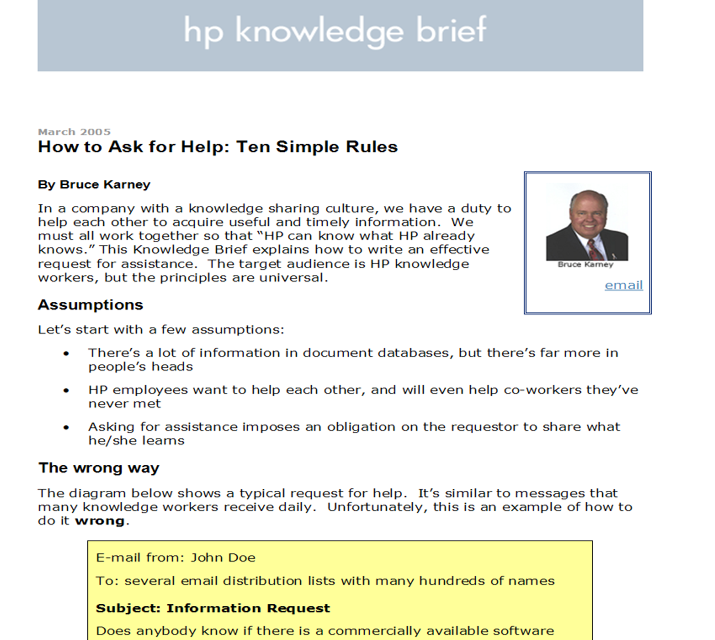The Five Cs of KM: Create Part 2 — Ideas and White Papers

Stan Garfield
In Part 1 of this final series related to the Five Cs of KM, I discussed connection and methods for creation. In this part, I discuss ideas and white papers.
Ideas
Good ideas exist throughout any organization but there may not be a good way to capture those ideas. These thoughts may just stop with the people who have them and not go anywhere. However, if you provide a way for those ideas to come forward as suggestions, they may represent opportunities that can be capitalized on for the benefit of everyone.
One approach to capturing ideas is an innovation management system. Some organizations have tools purchased or developed specifically for this function, often referred to as ideation, idea management, or idea creation. This approach offers a vehicle for submitting, tracking, and processing suggestions and ideas, with the goal of acting on the best ones.
Specialized systems for collecting and managing ideas are available as software products. An alternative is to use the existing Enterprise Social Network (ESN), which typically has good capabilities for people to make suggestions. In an ESN, suggestions can be solicited, tagged with a unique identifier, and acknowledged.
In either case, it is important to respond to those who take the time to offer a suggestion. Merely collecting ideas is not enough. People become frustrated if they never see what happens to those ideas. You can use the ESN to reply by thanking all contributors of ideas and explaining what will happen next. There are several possible responses. One is to confirm that a suggestion will be implemented and specify when it will happen. Another is to inform that the suggestion is already in effect or planned. And if the idea is unlikely to be used, an explanation should be provided. Closing the loop is important, even for suggestions that are not accepted. And it is essential to actually implement the best ideas.
Innovation challenges can be used to focus an organization’s attention and energy on knowledge creation. These can be one-time or recurring, with a theme and possibly a set of prizes. For example, a one-month innovation challenge to develop new ways to save on energy costs and consume energy in a more responsible and sustainable way. The goal is to get ideas flowing from as many people as possible, celebrate everyone who participates, and recognize and implement the best suggestions.
The idea behind knowledge creation is not only to collect documents and connect people, but to implement specific processes to stimulate innovation. Inspire people to offer ideas that are not only collected but celebrated and implemented. This results in a responsive organization in which people are recognized for their creativity.
White Papers
Establishing an easy process for white papers to be submitted, reviewed, and published can facilitate knowledge creation. Provide ways to subscribe to new publications in areas of interest, connect with the authors, and collaborate on further enhancements of published ideas. Encourage people to synthesize information from multiple white papers to create new and better methods, tools, and techniques.
An example of a white paper process was Hewlett-Packard’s Knowledge Briefs program. People were encouraged to write white papers on almost any worthwhile topic. The knowledge briefs typically were four or five pages long. This was a way for people to write up an explanation, method, or process so that other people could benefit. There was a formal submission process. To ensure it was useful and well written, a team reviewed each white paper. If it met established criteria it was accepted, published, and disseminated to make subscribers aware so they were able to apply the new knowledge.
An example of a knowledge brief was “How to Ask for Help: 10 Simple Rules” by my HP colleague, Bruce Karney. He documented a method to increase the likelihood of receiving useful answers when asking for help. Bruce wrote this because he had frequently received requests for help with insufficient information about the needs, thus frustrating the people trying to help. He took the time to write a white paper that explained in detail how to improve the odds of receiving assistance in response to requests for help. This is good example of how documenting proven approaches allows other people to read about and apply that knowledge productively.

In Part 3 of this series, I will discuss analysis, focusing on Appreciative Inquiry and Positive Deviance.

Stan Garfield
To learn more, please join us for “The Five Cs of Knowledge Management Part 5: Create”, the final webinar in this series presented by Stan Garfield on Wednesday, June 21, 2023 at 11 a.m. Pacific, 2 p.m. Eastern. (Can’t make it? Register anyway and we’ll send you a link to the recording and slides afterwards). Register now or call 604-278-6717
Never miss another post. Subscribe today!
Similar Posts
Lucidea’s Lens: Knowledge Management Thought Leaders Part 79 – David Garvin
KM expert David Garvin was a proponent of organizational learning to counter unpredictability in market forces and technology advances.
Lucidea’s Lens: Knowledge Management Thought Leaders Part 78 – Carl Frappaolo
KM expert Carl Frappaolo was the creator of Delphi’s Knowledge Management Methodology (KM2)
Lucidea’s Lens: Knowledge Management Thought Leaders Part 77 – Leif Edvinsson
Leif Edvinsson, Professor Emeritus at Lund University in Sweden, specializes in Intellectual Capital Management of Enterprises, Cities, and Nations
Lucidea’s Lens: Knowledge Management Thought Leaders Part 76 – Seth Earley
Seth Earley works in cognitive computing, knowledge engineering, data management systems, taxonomy, ontology, and metadata governance strategies.

Leave a Comment
Comments are reviewed and must adhere to our comments policy.
0 Comments